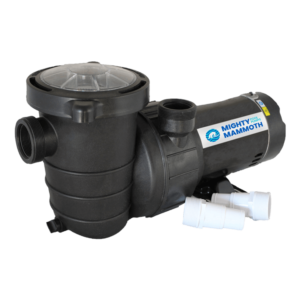
How to Completely Drain Water From an Above Ground Pool
Last Updated 9/16/2022
You should very rarely have to drain your pool completely. Doing so may cause damage to your pool liner. While uncommon, there may come the point where you have to drain your above ground swimming pool entirely. We recommend working with a pool professional, but draining your above ground pool is something many pool owners can do on their own with a bit of time and elbow grease!
Why Should I Drain My Above Ground Pool?
As noted, typical maintenance or winterizing your pool shouldn’t require you to drain the water completely. You risk damaging your pool liner and the structure of your above ground pool. Here are a few times you would likely have to drain all the water.
1. You’re removing or moving your swimming pool
Removing or moving your swimming pool can be a daunting task. If you plan to remove your pool, you must drain all the water and remove the liner. After the pool is emptied, you can take it apart. If you are moving your pool, you will need to drain all the water and empty it. Once it is emptied, you must tightly roll the pool wall and disconnect the pool filter system.
2. You plan to replace your pool liner
Replacing a pool liner is a big job, but it’s necessary if your liner is starting to show its age. Replacing a pool liner begins with draining the pool completely. Once the water is out, you can remove the old liner. Be careful, as sharp objects or nails sticking out of the frame could cause injury.
3. Your pool water quality can’t be fixed with chemical treatments and proper maintenance
It may be necessary to completely drain your pool if the water is cloudy, has algae growth, or contains high levels of metals or other contaminants. Draining your pool completely can help improve the water quality and help your pool to operate more efficiently.
How To Choose Your Pool Draining Method
It’s a matter of preference, time, and equipment when it comes to choosing your pool draining method.
There are two main options that pool owners typically choose from when getting ready to drain their above ground pool; an electric pump or garden hose siphon. Below is an overview of each drain method and the steps needed to complete the process.
 How To Drain An Above Ground Pool With A Sump Pump: Pump To Drain Water Method
How To Drain An Above Ground Pool With A Sump Pump: Pump To Drain Water Method
Draining your pool using a submersible electric pump, also known as a sump pump, is significantly faster than using a garden hose. But for this option, you’ll need an electric water pump.
- Submerge the pool pump’s intake hose under the water – as close to the center of the swimming pool as possible.
- Choose a space on your property for the pump’s outlet hose to drain. This area should be away from the pool, and the ground should be level to avoid flooding.
- Turn the electric pump on with clean, dry hands.
- As the pump begins to run, ensure your swimming pool’s water level is decreasing before leaving the equipment unattended as it drains.
- Frequently check on the swimming pool to avoid any flooding or equipment malfunctions.
- Turn the pump off once the water level is too low for it to drain any further (6-12 inches deep). An electric pump will not drain every inch of water from your swimming pool.
How To Drain An Above Ground Pool Without A Pump: Garden Hose Siphon Method
This pool draining process can be completed with one garden hose, but the more you use, the faster your water will drain. Here’s how to siphon water out of a pool:
- Submerge each hose, so it fills with your above ground pool’s water.
- Take one end of the garden hose out of the pool and place it in an area with level ground, where it won’t flood.
- Keep the other end of the hose submerged in the water, and ensure the liquid begins to siphon out of the pool.
- Frequently check the siphon to ensure the water level continues to decrease and there is no flooding.
- Remove the hoses once the water level remains stagnant (around 6-12 inches deep). Garden hose siphons will not drain all of your pool’s water.
How to Remove the Remaining Water from Your Above Ground Swimming Pool
Both methods of draining will not altogether remove all the water. As noted in the steps above, there will be anywhere from 6-12 inches of standing water left at the bottom of your pool. You can remove the extra liquid using a variety of methods and tools, including:
- Sucking up the excess water with a Wet Vac
- Sweeping the remaining water into the pool’s drain
- Removing the liner from the pool’s frame and flipping it over to (cautiously) dump the extra water onto your property
Risks When Draining Your Pool Completely
Although emptying your swimming pool is straightforward, some risks are associated with this maintenance process, specifically with the pool liner. If you are not draining your above ground pool to replace its liner, there are some important factors to consider before starting to protect the integrity of your pool.
- Loss of Shape: Above ground swimming pools hold their shape due to water. When about 75% of the liquid is drained, your pool will experience some loss of form. It’s essential to protect your pool from collapsing by draining it on a day when there are no high winds or bad weather that could cause the empty pool to become damaged.
- Damage from the Sun: The water in your swimming pool helps protect your liner from UV ray damage. Once the water is completely removed, your pool liner is at risk of warping and fading from the sun. LinerWorld’s pool experts recommend draining your above ground pool when it’s overcast.
- Development of Mold: If you’re removing the water to relocate your pool, you must take extra steps to prevent mold build-up on your pool’s liner. Packing up your liner when it’s still wet is a common cause of mold in these scenarios. Use towels or a wet vac to thoroughly dry the vinyl before storing it.
Before completely draining your pool, it’s important to plan out which drain method you want to use, ensure you have the proper equipment on-hand, and look at the weather forecast to minimize the risk of damage. LinerWorld recommends contacting a pool professional if you have questions or concerns before starting this process!
If you’re removing the water from your pool because you need to replace your liner, save even more money by shopping LinerWorld’s wide selection of colorful and eye-catching swimming pool liners!




[…] page, knows what steps are to be followed, and in what order. The first step should always include removing the water in a way that’s safe and keeps it away from the […]
My pool is not draining the water what should I do
Hi Iris! Give us a call or fill out or contact form here and one of our team members can help you out. https://linerworld.com/pages/contact-us-1
My pool cover failed and I have algae and some small sediments in my pool. How much water should I take out before refilling and running my filter?
Hi! Thanks for reaching out. Drain approximately 1/3 to 1/2 of the pool water. This should be enough to remove a significant amount of algae and sediment without destabilizing the pool structure. Never drain your pool more than halfway unless you plan to replace the liner.
Good morning,
Last year I purchased tons of metal out and other products on trying to get the metal out of my pool, no success. I finally came to the conclusion that I needed to drain the pool and get fresh water so decided to wait for this season. I purchased a surmisable pump to empty out my above ground pool. I would like to rinse the liner, is that a good idea before I put new (purchased pool water) in the pool. I cannot fill from my house I have well water and believe that was the problem.
Is there any other steps I should consider?
Thank you
Thanks for reaching out to us. While we cannot give advice on how to remove metal pieces from your pool water, we can give advice on caring for your liner in situations like this: We do not recommend fully draining your pool water unless you are planning to replace the liner. Fully draining your pool can compromise the liner and cause shrinking and tears around any cut holes. If you do not plan on replacing your liner, we recommend draining the pool no more than half-way.